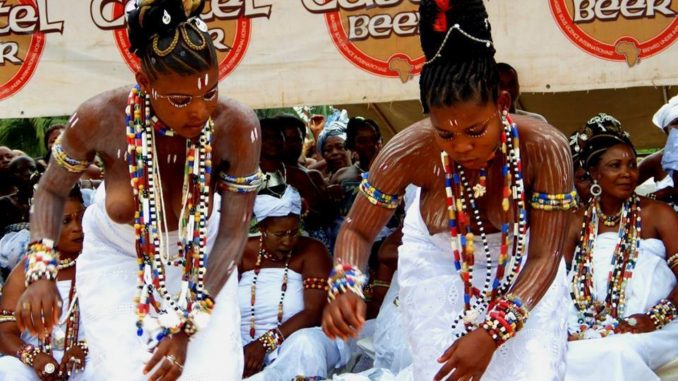
at Aneho in Togo West Africa. Togo and Benin, then part of of the pre-colonial African Kingdom of Dahomey, were the originators of vodoun/voodoo worship in the world. In Benin in particular Voodoo is their National religion with over 75% of the people identified as Vodoun/voodoo practitioners. They also have voodoo national holiday.
Voodoo (Vodun) is a derivative of the world’s oldest known religions which have been around in Africa since the beginning of human civilization.
Some conservative estimates these civilizations and religions to be over 10 000 years old. This then identify Voodoo as probably the best example of African syncretism in the Americas.
It would be a vain enterprise to claim to enumerate the types of Vodun or to classify them exhaustively. Mgr. Robert Sastre tried to tackle the question in Les Vodun dans la vie culturelle, sociale et politique du Sud-Dahomey. Honorat Aguessy did the same thing in Cultures Vodun, Manifestations – Migrations – Métamorphoses (Afrique, Caraïbes, Amériques). With this important background, in our approach we will focus on the mystical origin of the Vodun(s) as proposed by Fr. Mêdéwalé Jacob Agossou in Gbêto et Gbêdoto.
Firstly, the Vodun(s) are considered as the sons of Mawu, God the Creator. Here are the seven most important of these:
Sakpata: This is the eldest son of Mawu to whom the earth was entrusted: “Ayi Vodun”, the Vodun of the earth. His power is feared and terrifying. His attributes are the arm of smallpox, scissors, a chain and black, white and red spots. Sakpata has many sons, including the Vodun of leprosy (Ada Tangni), and of incurable sores (sinji aglosumato).
Xêvioso (or Xêbioso): This is the Vodun of the sky (Jivodun) who manifests himself in thunder and lightning. He is Mawu’s second son and is considered aVodun of justice who punishes thieves, liars, criminals and evil-doers. His attibutes are the thunderbolt, the double axe, the ram, the colour red and fire. Xêvioso has several sons including Sogbo, Aklobè, Avlékété.
Agbe: This is the Vodun of the sea (Tovodun). He is also known as Hu. He is represented by a serpent, a symbol of everything that gives life. One of his powerful children is Dan Toxosu who manifests himself in the birth of monster babies.
Gu: This is the Vodun of iron and war. He gives man his different technologies. He is the Vodun who does not accept complicity with evil. Therefore he is capable of killing all accomplices in acts of infamy if he is appealed to. This is expressed by the Fon saying “da gu do”.
Agê: This fifth son of Mawu is the Vodun of agriculture and the forests. He reigns over animals and birds.
Jo: This Vodun is characterized by invisibility. He is the Vodun of the air.
Lêgba: This is Mawu’s youngest son. He received no endowments at all because all had already been shared out among his elders. He is jealous, and it is he who loosens the rigid structure of the pantheon. He is the Vodun of the unpredictable, of what cannot be assigned to any other and he is characterised by daily tragedies; all that is beyond good and evil.
Alongside Mawu’s sons, one finds other Vodun(s) that are protectors of equally important clans. These are the Toxwyo: eponymous deified ancestors. They maintain a link between the invisible world and human beings in their daily lives.
From the above, we can classify the Vodun(s) as follows:
Inter-ethnic Vodun(s) linked to natural phenomena: Jivodun: Xêvioso;Ayivodun: Sakpata; Tovodun: Agbe.
Inter-ethnic Vodun(s) linked to historical-mythical persons: Lêgba, Gu.
Ethnic Vodun(s): Akovodun (Agasu for the Houégbajavi of Abomey). TheToxwyo are in this category.
Modern Vodun(s): These Vodun(s) are mainly from Ghana. They are Goro who protects against witchcraft, and Koku, the Vodun of the occult powers of violence.
After these investigations, it seems important to ask the question: so what exactly is Vodun?
It can be said that the Vodun(s) constitute a special class of Mawu’s living creatures. They are above mankind, but they are not “God”. Let us recognise, together with Fr. Barthélemy Adoukonou and all the others, that defining Vodun is not an easy task, even for Vodun adepts. Fon expressions like: “Vodun gongon”, “Vodun d’ablu” (Vodun is deep, Vodun is obscure) say it all. This is why, as Mgr. Robert Sastre said, we must refer to the social and cultural context which gives rise to Vodunin order to grasp what Vodun really is.
BY: Kweku Darko Ankrah
